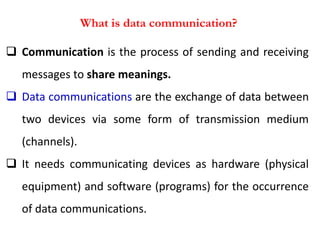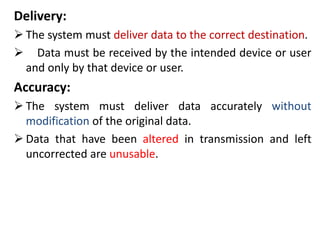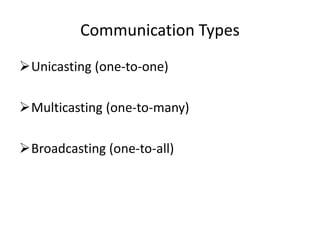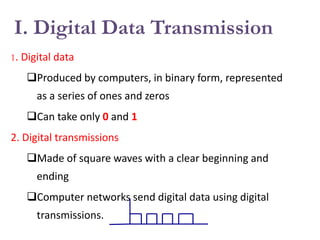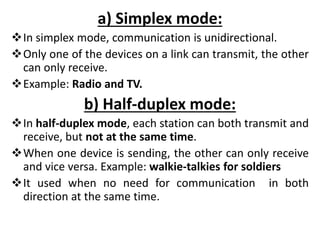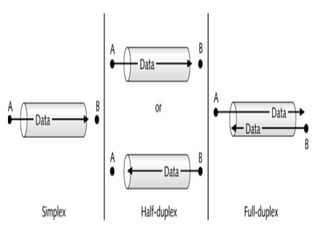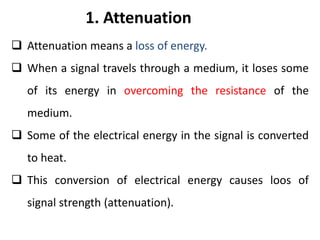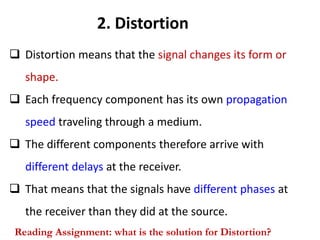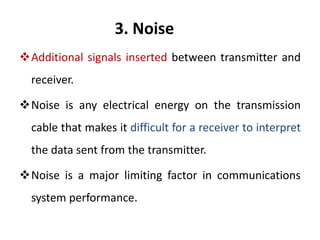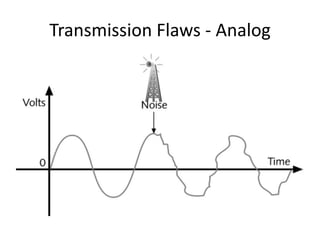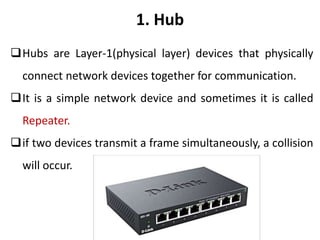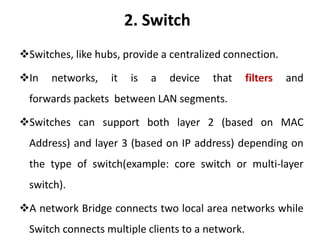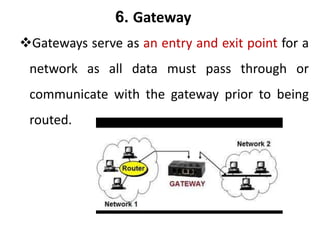2.pptx
- 2. Contents • Data communication • Computer network
- 3. Communication is the process of sending and receiving messages to share meanings. Data communications are the exchange of data between two devices via some form of transmission medium (channels). It needs communicating devices as hardware (physical equipment) and software (programs) for the occurrence of data communications. What is data communication?
- 4. Cont’d… For Data Communications to occur, the communicating devices must be part of a communication system made up of combining hardware and software. The effectiveness of data communication system depends on four fundamental characteristics: -Delivery, -Accuracy, -Timeliness, and - Jitter.
- 5. Delivery: The system must deliver data to the correct destination. Data must be received by the intended device or user and only by that device or user. Accuracy: The system must deliver data accurately without modification of the original data. Data that have been altered in transmission and left uncorrected are unusable.
- 6. Timeliness: Is information delivered in timely fashion? The system must deliver data in timely manner . Data that delivered late/delayed are useless. Jitter: Is information delivered in sufficiently smooth fashion? Refers to the variation in the packet arrival time. It is uneven delay in the delivery of audio or video packets. For example: Let us assume that video packets sent every 30ms. If some of packets arrive with 30ms delay and others 40ms delay, uneven quality in the video is the result.
- 7. Communication Types Unicasting (one-to-one) Multicasting (one-to-many) Broadcasting (one-to-all)
- 8. Components of Data Communications A data communications system has five components 1. Message: is the information (data) to be communicated. Popular forms of information include text, numbers, pictures, audio, and video. 2. Sender: is the device that sends the data message. It can be a computer, workstation, telephone handset, video camera, and so on. 3. Receiver: is the device that receives the message.
- 9. 4. Transmission medium: It is physical path in which a message travels from sender to receiver. Can be both guided and unguided. 5. Protocol: is a set of rules that govern data communications. It represents an agreement between the communicating devices. Without a protocol, two devices may be connected but not communicating, just as a person speaking English cannot be understood by a person who speaks only Amharic.
- 11. Data Transmission It is sending of binary data from source to destination as bit by bit or grouping bits together. The transmission of binary data across a link (communication channel) can be either parallel or serial mode. In parallel mode multiple bits are sent together each clock, where as In serial mode, 1 bit is sent with each clock tick.
- 12. Ways of Data Transmission
- 13. Parallel Transmission Multiple signals are sent in parallel Cannot travel long distances Example: printer connections
- 15. Serial Data transmission Signals are sent one bit at a time Travels long distances Example: telephone wires
- 18. Receiver waits ready for sender’s message and responds in real time (e.g. phone call, video- conferencing, Chats). 1. Synchronous Data Transmission The transmission is full-duplex type and is more reliable and efficient than asynchronous to transfer large amount of data. So, useful for high-speed applications and does not use stop/start bits – instead devices agree on timing.
- 19. 2. Asynchronous Data Transmission Both sender and receiver require no clock signals. It is half-duplex type of transmission. Have added parity bits (which called start and stop bit) for synchronize clock signals b/n sender and receiver. There is gap b/n frames or group of bits (bytes) by start and stop bits (e.g. Email, Letters).
- 20. Analog and Digital Data Transmission
- 21. I. Digital Data Transmission 1. Digital data Produced by computers, in binary form, represented as a series of ones and zeros Can take only 0 and 1 2. Digital transmissions Made of square waves with a clear beginning and ending Computer networks send digital data using digital transmissions.
- 22. II. Analog Data Transmission 1. Analog data Produced by telephones Sound waves, which vary continuously over time Can take on any value in a wide range of possibilities 2. Analog transmissions Analog data transmitted in analog form (vary continuously) Examples of analog data being sent using analog transmissions are broadcast TV and radio.
- 25. Modes of Data Transmission
- 26. a) Simplex mode: In simplex mode, communication is unidirectional. Only one of the devices on a link can transmit, the other can only receive. Example: Radio and TV. b) Half-duplex mode: In half-duplex mode, each station can both transmit and receive, but not at the same time. When one device is sending, the other can only receive and vice versa. Example: walkie-talkies for soldiers It used when no need for communication in both direction at the same time.
- 27. c) Full-duplex mode: In full-duplex mode, both stations can transmit and receive simultaneously. Example: telephone network When people are communicating by a telephone line, both can talk and listen at the same time.
- 29. Transmission Impairments Signals travel through transmission media, which are some time not perfect. The imperfection causes signal impairment. This means that the signal at the beginning of the medium is not the same as the signal at the end of the medium. With any communications system, the signal that is received may differ from the signal that is transmitted, due to transmission impairments.
- 30. Consequences over two types of signals : For analog signals: degradation of signal quality For digital signals: bit errors The most significant impairments include Attenuation Distortion Noise
- 31. 1. Attenuation Attenuation means a loss of energy. When a signal travels through a medium, it loses some of its energy in overcoming the resistance of the medium. Some of the electrical energy in the signal is converted to heat. This conversion of electrical energy causes loos of signal strength (attenuation).
- 32. Measurement of Attenuation To show the loss or gain of energy the unit “decibel” is used. dB = 10log10P2/P1 Where as P1 is input signal and P2 is output signal These problems are dealt with by the use of amplifiers or repeaters by amplifying the signal.
- 33. Suppose a signal travels through a transmission medium and its power is reduced to one-half. This means that P2 is (1/2)P1. In this case, the attenuation (loss of power) can be calculated as A loss of 3 dB (–3 dB) is equivalent to losing one-half the power. Example 1 of Attenuation…
- 34. A signal travels through an amplifier, and its power is increased 10 times. This means that P2 = 10P1 . Then compute the amplification or gain of power by amplifier. Solution: Example 2 of Attenuation…
- 36. 2. Distortion Distortion means that the signal changes its form or shape. Each frequency component has its own propagation speed traveling through a medium. The different components therefore arrive with different delays at the receiver. That means that the signals have different phases at the receiver than they did at the source. Reading Assignment: what is the solution for Distortion?
- 37. Additional signals inserted between transmitter and receiver. Noise is any electrical energy on the transmission cable that makes it difficult for a receiver to interpret the data sent from the transmitter. Noise is a major limiting factor in communications system performance. 3. Noise
- 39. Transmission Flaws - Analog
- 40. Transmission Flaws - Digital
- 41. Noise - solutions Twisting cables – effect of one signal cancels the other. Shielding – reduce interference from outside source.
- 42. Network Devices and Their Role
- 43. 1. Hub Hubs are Layer-1(physical layer) devices that physically connect network devices together for communication. It is a simple network device and sometimes it is called Repeater. if two devices transmit a frame simultaneously, a collision will occur.
- 44. As an active hubs regenerate signals, it increases the distance that can be spanned by the LAN (up to 100 meters per segment). Hubs can also be connected locally to a maximum of two other hubs, thereby increasing the number of devices Active hubs are usually used against attenuation, which is a decrease in the strength of the signal over distance. Advantages of Hub
- 45. Limitation of Hub Hubs cannot filter data: i.e. data packets are sent to all connected devices/computers and do not have intelligence to find out best path for data packets. This leads to inefficiencies and wastage. Any data packet coming from one port is sent to all other ports. It is then up to the receiving computer to decide if the packet is for it.
- 46. 2. Switch Switches, like hubs, provide a centralized connection. In networks, it is a device that filters and forwards packets between LAN segments. Switches can support both layer 2 (based on MAC Address) and layer 3 (based on IP address) depending on the type of switch(example: core switch or multi-layer switch). A network Bridge connects two local area networks while Switch connects multiple clients to a network.
- 47. Rather than forwarding data to all the connected ports, a switch forwards data only to the port on which the destination system is connected. It looks at the Media Access Control (MAC) addresses of the devices connected to it to determine the correct port. A MAC address is a unique number that is stamped into every NIC. Switch…
- 48. 3. Repeaters It operates on physical layer (i.e. layer 1) of the OSI Reference Model. Two, or more, such LANs could be interconnected to extend the length limitation by means of a device known as a repeater. It is primarily concerned with the transmission of electrical signals at bit level.
- 49. 4. Bridge Bridges are used to connect separate LANs together. It performs ‘filtering’ function. All other intra-network frames are rejected by the bridge.
- 50. Bridge… The function of the bridge is to make intelligent decisions about whether or not to pass signals to the next segment of a network. When a bridge sees a frame on the network, it looks at the destination MAC address and compares it to the forwarding table to determine whether to filter, flood, or copy the frame onto another segment. A bridge only has one incoming and one outgoing port. Operate at data link layer of network
- 51. 5. Router Routers operate at the Network layer of the OSI model. They are slower than bridges and switches but make "smart" decisions on how to route packets received on one port to a network on another port. A router, like a switch forwards packets based on address. Usually, routers use the IP address to forward packets, which allows the network to go across different protocols.
- 52. Routers support different WAN technologies but switches do not. Networks served by a router are not required to use the same protocol. Routers are frequently used to place additional security on sensitive networked resources. Routers are located at gateways, the places where two or more networks connect.
- 53. 6. Gateway Gateways serve as an entry and exit point for a network as all data must pass through or communicate with the gateway prior to being routed.
- 54. Cont… It serves as a single access point and a converter to connect dissimilar networks using different protocols and different models(i.e OSI and TCP/IP models). A gateway is a computer that operates in all seven layers of the OSI model. A gateway takes an application message, reads it, and interprets it.
- 55. Thank you!!


